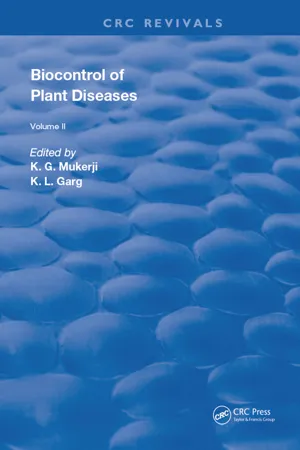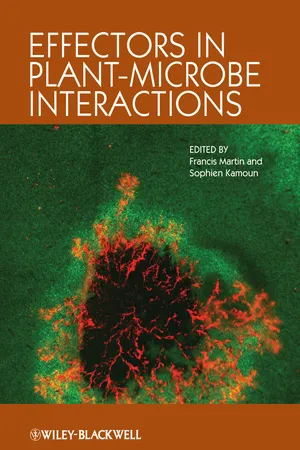Biological Sciences
Leaf Rust
Leaf rust is a fungal disease that affects plants, particularly cereal crops like wheat and barley. It is caused by the fungus Puccinia triticina and is characterized by orange or rust-colored pustules on the leaves. Leaf rust can lead to reduced photosynthesis and yield losses in affected crops, making it a significant concern for agricultural productivity.
Written by Perlego with AI-assistance
4 Key excerpts on "Leaf Rust"
- eBook - ePub
- K. G. Mukerji, K.L. Garg(Authors)
- 2020(Publication Date)
- CRC Press(Publisher)
Chapter 1BIOCONTROL OF RUST AND LEAF SPOT DISEASES *
J. K. Sharma and K. V. Sankaran
TABLE OF CONTENTS
Acknowledgment ReferencesI. Introduction II. Biological Control in Nature A. Hyperparasitism 1. Rust 2. Leaf Spots B. Antagonism 1. Naturally Occurring Antagonists 2. Foreign Antagonists C. Immunization D. Hypovirulence III. Future Prospects I. INTRODUCTION
Among the greatest hazards in crop production, unfavorable weather conditions, insect pests, and diseases are the main factors. Any one of them can upset the crop yields with catastrophic suddenness. Of all the plant diseases, foliar diseases, especially rusts and leaf spots, are the important group of diseases causing large-scale destruction of agricultural and horticultural crops. There are about 4000 species of rust fungi belonging to 100 genera, many of which are capable of causing widespread epidemics. A few notable examples are those of cereal rusts (Puccinia graminis f. sp. tritici, P. graminis f. sp. secalis), cedar rust of apple (Gymnosporangium juniperi-virginianae), and white pine blister rust (Cronartium ribicola), which are well known for causing economic losses. Cereal rusts are known to have changed the cropping pattern of different regions and food habits of the population. Wheat Leaf Rust created an economic disaster in 1916 in the U.S. and Canada. An even worse disaster struck in 1935 when about 100 million bushels of wheat were lost. In India, according to an estimate during 1971 to 1972, a brown rust (Puccinia recondita) epidemic in northwestern India resulted in a loss of 1.5 million tonnes of wheat.79 Epidemics of the coffee rust compelled Sri Lanka to bring more land into tea plantations and to abandon coffee cultivation for years. This way coffee rust changed the entire economy of Sri Lanka in 1875 due to the widespread rust epidemic. Leaf spot diseases are equally significant in causing economic disasters. To name a few, late blight of potato (Phytophthora infestans), blast of rice (Pyricularia oryzae), Helminthosporium leaf spot of maize (H. turcicum, H. maydis, H. carbonum), and bean anthracnose (Colletotrichum lindemuthianum) are known to have affected crop yields drastically. The potato famine of Ireland in 1845, due to late blight, which gradually spread to the whole of the European continent, is the most cited example to indicate destruction and aftereffects of diseases on a large population. Rice blast disease, reported from 70 countries has affected up to 90% of the yield depending upon the part of the plant infected. In the 1950s in Florida, losses of winter-grown sweet corn due to leaf spot caused by H. turcicum - eBook - ePub
- S. Parthasarathy, G. Thiribhuvanamala, K. Prabakar(Authors)
- 2020(Publication Date)
- CRC Press(Publisher)
Chapter - 2Diseases of Wheat - Triticum aestivum L.S. No. Disease Pathogen 1. Black (stem) rust Puccinia graminis var. tritici2. Orange brown (leaf) rust Puccinia triticina3. Yellow (stripe) rust Puccinia striiformis4. Loose smut Ustilago tritici5. Flag smut Urocystis tritici6. Rough spored bunt Tilletia tritici7. Smooth spored bunt Tilletia laevis8. Dwarf bunt Tilletia controversa9. Karnal bunt Tilletia indica10. Powdery mildew Blumeria graminis f.sp. tritici11. Leaf blight Alternaria triticina12. Pythium foot rotGlobisporangium abappressorium13. Pink snow mold Microdochium nivale14. Fusarium foot rotFusarium culmorum15. Tan spot Pyrenophora tritici-repentis16. Tundu Clavibacter tritici + Anguina tritici17. Bacterial leaf streak and black chaff Xanthomonas translucens18. Soil borne mosaic disease Soil-borne mosaic virus19. Take all disease Gaeumannomyces graminis20. Scab (The Fusarium Head Blight) Fusarium graminearum21. Leaf blotch Mycosphaerella graminicola; Leptosphaeria nodorum; Leptosphaeria avenaria22. Molya disease Heterodera avenaeWheat Rust
Aristotle (384–322 B.C.) writes of rust being produced by the “warm vapors” and mentions the devastation of rust and years when rust epidemics took place. Theophrastus reported that rust was more severe on cereals than legumes.Wheat rust pathogens belong to genus Puccinia, family Pucciniaceae, order Uredinales and class Basidiomycetes. These rust fungi are highly specialized plant pathogens with narrow host ranges. The Italians Fontana and Tozzetti independently provided the first unequivocal and detailed reports of wheat stem rust in 1767 (Fontana, 1932; Tozzetti, 1952). Chester (1946) provided one of the first detailed histories of the literature on the rust of wheat. In the early records, wheat Leaf Rust is not distinguished from stem rust (Chester, 1946).The first stem rust epidemic record goes back to 1786 A.D. in central India. Widespread occurrence of Leaf Rust was observed during 1971–73 in popular cultivar Kalyansona in northern plains. Both Leaf Rust and stripe rust occurred each year from 1967 to 1974 but the losses were estimated only twice. - eBook - ePub
- Anne Marte Tronsmo, David B Collinge, Annika Djurle, Lisa Munk, Jonathan Yuen, Arne Tronsmo(Authors)
- 2020(Publication Date)
- CAB International(Publisher)
Anton de Bary did not stop with potato late blight, however, and proceeded to unravel the mysteries of rust fungi. For the first time (1853) a life cycle of a fungal pathogen was described. While these were some of the earliest known plant pathogens, the complex relationships between the different spore stages were not clear with rusts, with different fungal names being given to the different stages. That there was a relationship between barberry plants and stem rust had been suspected, and legislation in Rouen in France in 1660, and in Massachusetts, USA, in 1755, dictated eradication of barberry plants near wheat fields as a control measure, even without knowing the actual relationship. In Denmark there was a controversy between proponents of barberry as a beneficial hedge plant and opponents, such as the schoolteacher Nicolay P. Schøler. In 1813, he published evidence that rust spread to wheat and rye from barberry, and followed with, for the time, a substantial experimental programme. The barberry debate lasted for 60 years until de Bary, between 1860 and 1865, finally discovered that stem rust is heteroecious. It would be several decades before Craigie in 1927 described the true function of the pycniospores.Specialization within Puccinia graminis, which causes stem rust, was further described by Jakob Eriksson (Fig. 2.1C ) and Ernst Henning in 1896. Through careful inoculation experiments, Eriksson and Henning were able to show that the rust spores from wheat, for example, could not infect barley. They coined the term formae speciales to describe these variants of the rust.Coffee rust Hemileia vastatrix was detected in 1869, and the coffee industry in Sri Lanka was devastated by 1890, leading to tea as a replacement crop. Coffee rust is still a major cause of losses and is predicted to increase as a threat with global warming.Naming of the causal disease organisms has always been a challenge. But thanks to the Swedish mycologist Elias Magnus Fries and the Dutch mycologist Christiaan Hendrik Persoon, the modern taxonomy of fungi was presented in 1821 based on systematics of Carl von Linné.BacteriaWhile it was originally thought that only fungi could cause plant diseases, there were other diseases where no fungi could be isolated or observed. One of these was fireblight, a disease native to North America that affects flowers, shoots, and even branches of pear, apple and quince trees, giving a burned appearance to the foliage. It was first described in 1817 by William Coxe, writing about fruit production in the US. Thomas J. Burrill, at the University of Illinois, examined the exudate from affected limbs and observed minute particles in it, using a Zeiss microscope he had imported from Germany. He concluded that these were bacteria and that they were the causal agent of the disease. He named the bacterium Micrococcus amylovorus in 1882, but the name was subsequently changed to Erwinia amylovora - eBook - ePub
- Francis Martin, Sophien Kamoun(Authors)
- 2011(Publication Date)
- Wiley-Blackwell(Publisher)
Molecular Plant-Microbe Interactions 24(7), 808–818. .Ellis, J.G., Rafiqi, M., Gan, P., et al. (2009) Recent progress in discovery and functional analysis of effector proteins of fungal and oomycete plant pathogens. Current Opinion in Plant Biology 12, 399–405.Feau, N., Joly, D.L., & Hamelin, R.C. (2007) Poplar Leaf Rusts, model pathogens for a model tree. Canadian Journal of Botany 85, 1127–1135.Fernandez, D., Tisserant, E., Talhinhas, P., et al. (2011) 454-pyrosequencing of Coffea arabica leaves infected by the rust fungus Hemileia vastatrix reveals in planta expressed pathogen-secreted proteins and plant functions expressed in a late compatible plant-rust interaction. Molecular Plant Pathology . doi:10.1111/j.1364-3703.2011.00723.x.Fehser, S., Beike, U., Stöveken, J., et al. (2010) Histological and initial molecular analysis of Ug99, the sr31 -breaking race of the wheat stem rust fungus. Journal of Plant Pathology 92, 709–720.Flor, H.H. (1971) Current status of gene-for-gene concept. Annual Review of Phytopathology 9, 275–296.Gan, P.H.P., Rafiqi, M., Ellis, J.G., et al. (2010) Lipid binding activities of flax rust AvrM and AvrL567 effectors. Plant Signaling and Behavior 5, 1272–1275.Godfrey, D., Bohlenius, H., Pedersen, C., et al. (2010) Powdery mildew fungal effector candidates share N-terminal Y/F/WxC-motif. BMC Genomics 11, 317.Graca, R.N., Ross-Davis, A.L., Kim, M-S., et al. (2010) Molecular population genetics of guava rust Puccinia psidii , an invasive pathogen of native Hawaiian forests and a potential threat to eucalypts worldwide. Phytopathologia Mediterranea 49, 421–434.Grouffaud, S., van West, P., Avrova, A.O., et al. (2008) Plasmodium falciparum and Hyaloperonospora parasitica effector translocation motifs are functional in Phytophthora infestans
Index pages curate the most relevant extracts from our library of academic textbooks. They’ve been created using an in-house natural language model (NLM), each adding context and meaning to key research topics.
Explore more topic indexes
Explore more topic indexes
1 of 6
Explore more topic indexes
1 of 4



